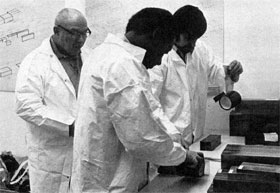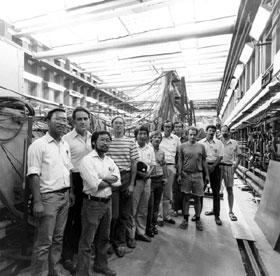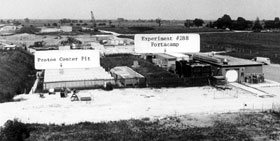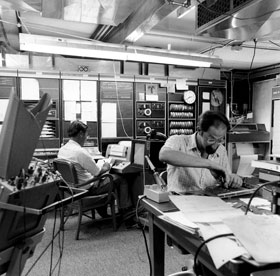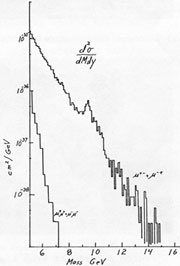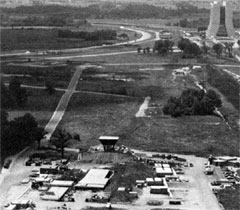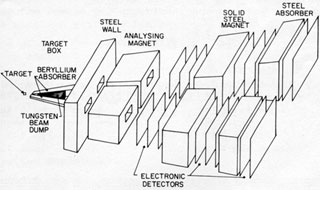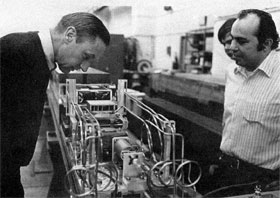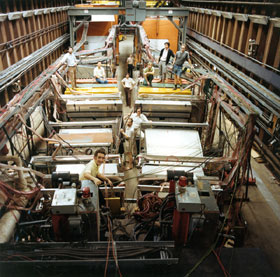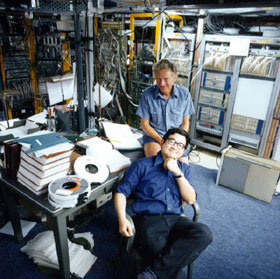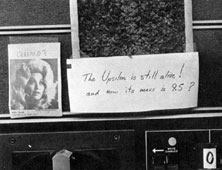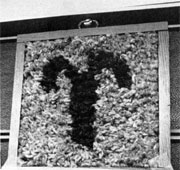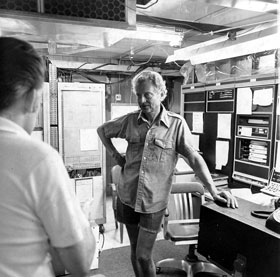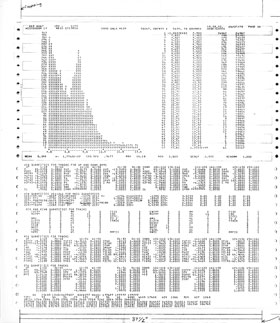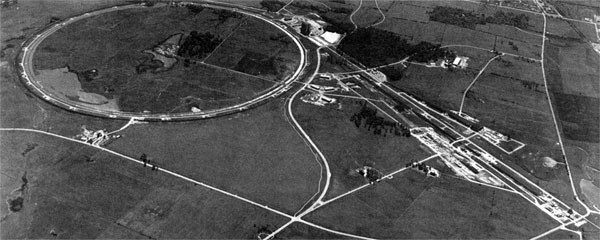!!Extra!! Fermilab Experiment Discovers New Particle "Upsilon"
A New Chapter In High-Energy Physics
This complicated array of numbers has revealed a fascinating, new aspect of the universe. A group of physicists searched this coded information, recorded by their electronic detectors, and uncovered there an unexpected new particle. They have named this new particle with the Greek letter Υ (Upsilon).
The Upsilon is more than ten times heavier than the proton; it is by far the heaviest sub-nuclear particle ever discovered. High-energy physicists around the world are excited by the vistas which the new discovery opens.
The discovery is the fruit of many years' effort by the experimenters and the Fermilab staff. In this issue we hope to share some of the excitement of this event and to acknowledge many who have helped.
A FERMILAB VICTORY!
Members of a team of physicists from Columbia University, Fermilab, and the State University of New York at Stony Brook are flashing jubilant smiles all over the Fermilab site and, in fact, all over the United States and Europe. The group uncovered UPSILON, a sub-nuclear particle with a mass of 9.5 BeV - in the Proton Center experimental area during a run which began last May 17.
Upsilon is four times heavier than the particle discovered in 1976 by another team at Fermilab representing Columbia University, Fermilab, the University of Hawaii and the University of Illinois Urbana-Champaign. Their particle is referred to as a "charmed baryon," and it became an example of "naked charm" which validated much of the speculation about "charmed" quarks.
"Everyone who works at Fermilab has had a piece of the Upsilon action," Director R. R. Wilson reminds. "In some way everyone has contributed and we all have the right to feel proud of what they have done and what we have done." What follows in this issue of the Crier is by way of explaining what the experiment is in order that you may see where your contribution fits in.
WHAT IS IT?
For some time in the field of high-energy physics, speculation was that all matter is made up of combinations of just two "quarks." One was whimsically called the "up" quark and the other, the "down" quark. A proton is two up quarks and one downer, while the neutron is two downers and one upper. Mesons are even simpler; they are just two quarks in various combinations.
But matter is more subtle than that, and some rarely-seen particles that last less then ten millionths of a second have one of the common quarks replaced by a third quark, called the "strange" quark. In 1974, a fourth quark appeared; it was named the "charmed" quark. It was discovered simultaneously at Brookhaven National Laboratory and the Stanford Linear Accelerator Center, but many of the essential contributions to the knowledge about charm were done at Fermilab. The charmed baryon discovery, mentioned previously, was one of these.
Now it appears that a fifth, even more elusive quark has turned up in this new discovery. The final explanation may turn out to be entirely different, but the excitement that the discovery has generated should stimulate all of us to dig into our roles in helping to uncover the meaning of this new revelation.
THE COURSE OF THE EXPERIMENT
What did they do? Spokesman Leon Lederman recounts: The group actually proclaimed its intention to make important discoveries in its 1970 proposal (see "Brief History of the Work," this issue). After a long period of what Dr. R. R. Wilson jocularly refers to as "horsing around," the group tightened its goals in the spring of 1977. It set out to study the rare events that occur when a pair of muons or electrons is produced in a collision of the proton beam from the accelerator on a platinum target. Searching for this unique reaction requires the finest of "filters" to eliminate every other reaction. Only one Upsilon is produced for every 100 billion protons which strike the target, and the experimenters must sort out this single event. So far, about 1,000 Upsilon particles have been observed.
The run began May 15. By the end of the first week, an enhancement of events near 9.5 BeV became very evident.
Data-taking was interrupted by a fire in the Proton Center pit on May 22. The fire was quickly extinguished, but chlorine vapors and the below-ground humidity combined to form a corrosive acid which threatened the electronics of the experiment.
A fire salvage expert was summoned from Europe and, together with the prodigious efforts of Rich Orr, John Colson, the Proton Department personnel, and the physicists of the experiment, 900 electronic circuit boards were cleaned in secret-formula solutions flown in from Frankfurt, Germany.
By Friday, May 27, the experiment was back on the air. A week later, the group became convinced that their data "bump" was real, but further data-taking continued. Taiji Yamanouchi wanted more checks. Walter Innes insisted on sensible statistical studies. John Yoh demanded that someone check his programs. Grad student Dan Kaplan worried about his on-line program.
By June 15 everyone was satisfied and the news was leaking out. The "bump" was becoming obvious in the printouts from the 7th floor computers. A seminar was scheduled and given by Steve Herb to a full house in the Fermilab Auditorium. And the group broke out a bottle of champagne saved for just such an emergency.
WHAT LED TO THE SUCCESS?
In March the Proton Department site support group began a new set of target "drawers" for the historic experiment. The drawers had been prepared in the preceding months by the Proton Department mechanical group and the instrumentation group. The improved design of this targeting system incorporated over a third of a ton of beryllium. This metal was sculpted into precision shapes to fit the triangular apertures of the two-arm experiment. The hadron-absorbing property of this material was a major factor in eliminating "backgrounds" for the Upsilon search.
In this new equipment, particles emerging at small angles plow into a six-foot tungsten "dump" which absorbs most of them. Particles at larger angles (three to six degrees) enter an 18-foot filter containing about 12 cubic feet of the beryllium. The beryllium absorbs strongly-interacting particles, such as pions and protons, but passes muons with a minimum of scattering, permitting accurate measurement of their trajectories and momenta with magnets and particle detectors after the target box. This information is stored on magnetic tape and the Fermilab 6600 computer is used to calculate a precise value for the mass of the parent particle which produced each pair of muons.
Acquiring the beryllium for this experiment required a nationwide effort last winter. Beryllium is both expensive and scarce. To acquire two metric tons involved the best planning of the Proton Department staff, Fermilab Materials Management, and the local Energy Research and Development Administration officials. The hunt finally led to an almost-forgotten warehouse in Oak Ridge, Tennessee where leftover beryllium from a project there was discovered. The precious metal was trucked to Fermilab together with a small amount from the Argonne National Laboratory.
The muons emerging from the beryllium filters are deflected by two large analyzing magnets built for the original experiment in 1970. The paths of the muons are then recorded in large detectors called Multiwire Proportional Chambers (MWPC's) which were fabricated in the Fermilab Physics Department and at Columbia University. The information from the detectors is coded electronically and with the help of a small "online" computer is written on magnetic tape.
It is these magnetic tapes, containing over 20 million records of possible muon pairs, that must be analyzed to produce the graph which reveals the Upsilon as shown on page one of this Crier. This job would be hopeless without the aid of the large CDC 6600 computers in the Fermilab Computing Department. The task involves many stages of sorting through the data, trying to determine whether the electronic detectors are working as expected, and trying to identify the few interesting pairs of muons in the sea of other uninteresting (at least to this particular experiment) nuclear fragments. The experimenters "see" the tracks of the two muons only by way of a schematic computer print-out of the decoded electronic detector data.
"All these efforts allowed the experiment to run at higher beam intensities than ever before and to more sensitively probe the dilepton mass spectrum," according to Brad Cox, head of the Proton Department.
The experimenters insist that any progress they have made is the result of the efforts of many people. "Over the last five years every department in the lab has at one time or another contributed to the purchase, fabrication and assembly of our experimental apparatus. to the successful running of the accelerator to the exacting standards needed for the experiment; to the smooth operation of the Proton Center area; to the rapid analysis of the data," Chuck Brown comments.
"In particular the experimenters wish to acknowledge the efforts of Brad Cox, Ron Currier, Bill Thomas, Dave Eartly, Age Visser, Al Guthke, Bob Shovan, Ed Tilles, Fred Rittgarn and the many mechanical and electrical technicians in the Proton Area department."
Excellent technical help in running the equipment was given by Ken Gray of Columbia University and Jack Upton, Frank Pearsall and Karen Kephart of the Fermilab Physics Department.
SOME COMMENTS
According to Chuck Brown, the important questions to ask now are: What is this new particle, or, more importantly, why is it? The Upsilon isn't needed to fit any obvious hole in the present set of known sub-nuclear particles.
Secondly, it will take many more experiments to determine all of the properties of the Upsilon (and any relatives which it most likely has).
Leon Lederman notes that "speculation is mounting that a new pair of quarks exists. These have been given such fanciful names as "truth" and "beauty" or, more prosaically, "top and bottom."
"The Upsilon fits very nicely into the picture of a super-atom consisting of the bound state of a bottom quark and antiquark. Proof of this hypothesis will depend on a clearer delineation of the mass distribution. This is in progress at Fermilab. Conclusive proof will require the observation of 'naked bottom' - that is, particles containing only one bottom quark."
At the present time, Lederman observes, the state of the data is such that other interpretations of the discovery are tenable. The researchers hope to explore this over the next several months. Meanwhile it is a matter of intense significance as to whether the picture of basic building blocks is now complete or whether the number of quarks and leptons will continue to increase. A continued increase would raise fundamental questions as to the very meaning of elementarity. It would challenge the belief that "nature is intrinsically simple," Lederman feels.
MEMBERS OF UPSILON COLLABORATION
Fermilab physicists: J. A. Appel, B. C. Brown, C. N. Brown, W. R. Innes, K. Ueno, and T. Yamanouchi.
Physicists from Columbia University include S. W. Herb, D. C. Hom, L. M. Lederman, J. C. Sens, H. D. Snyder, J. K. Yoh.
State University of New York at Stony Brook physicists include A. S. Ito, H. Jostlein, D. M. Kaplan, and R. D. Kephart.
Experiment 288, run at Fermilab in 1977, is assured of a permanent place in the history of particle physics. For it was this experiment that found the upsilon, the heaviest subnuclear particle known to date, and opened up a whole new chapter in the study of the nature of matter. The photograph shows a computer printout of processed data. The histogram in the top-left portion of the photograph clearly shows a peak that indicates the presence of a new particle with a mass of 9.5 GeV (billion electron volts). The various particle detectors in the experimental apparatus translated the flight path of scattered particles into electrical signals. These signals were then processed electronically into coded numbers and recorded on magnetic tape. Later, the experimenters, using a sophisticated computer, decoded, manipulated and displayed in a simpler form the events recorded in the detector. The tables of numbers that result, such as the one in this photo, give the physicists an accurate "picture" of what the electronic apparatus saw.
